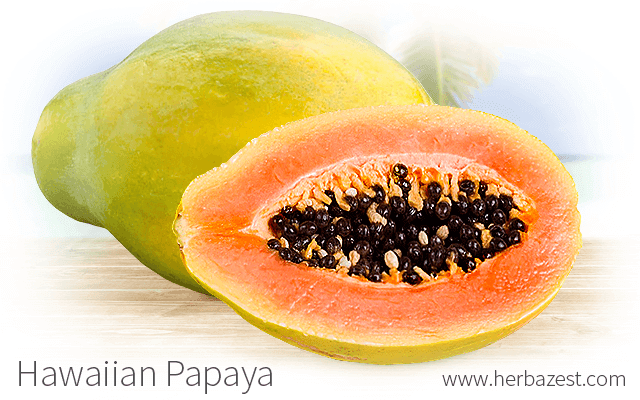In 1526, the Spanish explorer Gonzalo Oviedo was the first to give a written account of papaya production in modern-day Panama and the Dominican Republic. In the years that followed, the papaya tree would spread outwards from Central America to other tropical sites around the world.
Of the many regions where people cultivate papaya, Hawaii has become the major powerhouse of production. In the Central Pacific archipelago, the Carica papaya species has been extensively studied and greatly improved.
History of the Hawaiian Papaya
Thought to have presumably arrived from Jamaica or Barbados, papaya seeds first made it to Hawaii during the early 1800's. These fruits were large and melon-like and were grown for nearly a century before the emergence of the now-popular Hawaiian 'Solo' variety.
Dr. Garritt P. Wilder of Honolulu is the Hawaiian horticulturist credited to having introduced the 'Solo' papaya. In 1911, he sent the seeds of a small papaya fruit to researchers at the Hawaii Agricultural Experiment Station, thereby initiating a revolution in the papaya industry. By 1936, the 'Solo' variety had replaced all other Hawaiian papayas of the time.
As consumers flocked to purchase the delicious fruits, papaya production skyrocketed. In 1992, however, many of Hawaii's papaya crops were plagued by the sudden onslaught of a plant disease called papaya ringspot virus. With no known solutions besides prevention and removal of infected plants, Hawaiian papaya trees could not recover from the deadly infection, which wreaked havoc on their leaves, stems, and fruit development.
Hawaii's top papaya-producing district, Puna, suffered a particularly staggering loss because of it, producing over 20 million pounds (9 million kg) less in 1997 than it did in 1992.
Characteristics of Hawaiian Papayas
The internationally-acclaimed Hawaiian papayas are cultivars based on the 'Solo' variety. So called for their small, personal-sized fruits, these papayas are much valued for their superior texture and their 12 - 15% sugar content. These papaya tree-like plants bear pear-shaped fruits of between one to two pounds (450 - 900 g), with succulent red or yellow flesh. Their size has also been a major factor in crop appeal, attracting buyers who may have been reluctant to splurge on the earlier, watermelon-like fruits.
Widely studied by researchers and botanists, many papayas in Hawaii have been the subject of selective breeding programs and genetic monitoring. After several generations, they are considered genetically stable, producing true to seed. Moreover, as a result of these crop improvement efforts, Hawaii's red papaya cultivars have been adapted to many different climatic conditions.
With the highest concentration of natural sugars, the 'Solo Sunrise' cultivar is the most important Hawaiian papaya for world trade. On the other hand, it has the shortest shelf life of all cultivars and must be quickly marketed and sold. Meanwhile, the 'SunUp Solo' and 'Rainbow Solo' - having been expressly developed for their increased immunity against papaya ringspot virus - are also agriculturally significant.
Other notable cultivars are 'Kapoho Solo', 'Waimanalo Solo', and 'Sunset Solo', all of which have a good shelf life, but are prone to fruit deformities and other complications when subjected to inadequate climate conditions.
Thanks to their compact sizes, premium crop quality, and sweet, succulent flavor, Hawaiian papayas are preferred around the world. With unique plant characteristics that respond to a wide range of consumer and grower needs, papayas in Hawaii have gained immense commercial importance.
Sources
- American Phytopathological Society, Transgenic virus-resistant papaya: The Hawaiian ‘Rainbow’ was rapidly adopted by farmers and is of major importance in Hawaii today
- Firsts and Almost Firsts in Hawai'i, p. 21
- Genetics and Genomics of Papaya, pp. 97-98
- International Tropical Fruits Network, Papaya – Introduction | Common Varieties | Market and International Trade
- National Nutrient Databank Conference, Vitamin and mineral content of tropical fruit cultivars grown in Hawaii
- State of Hawaii, Department of Agriculture, History of agriculture in Hawaii
- University of Hawaii, Papaya production in Hawaii | Papaya ringspot virus (PRV): A serious disease of papaya | The Rainbow story




